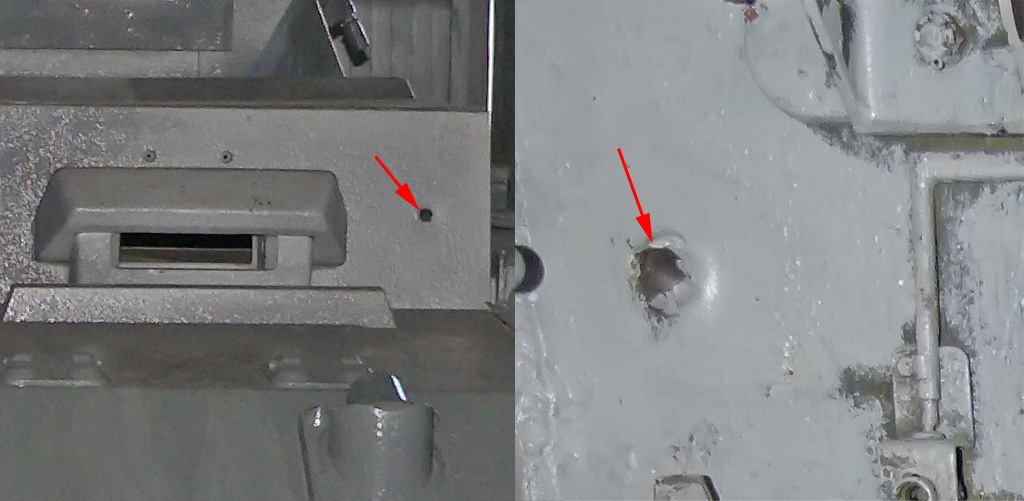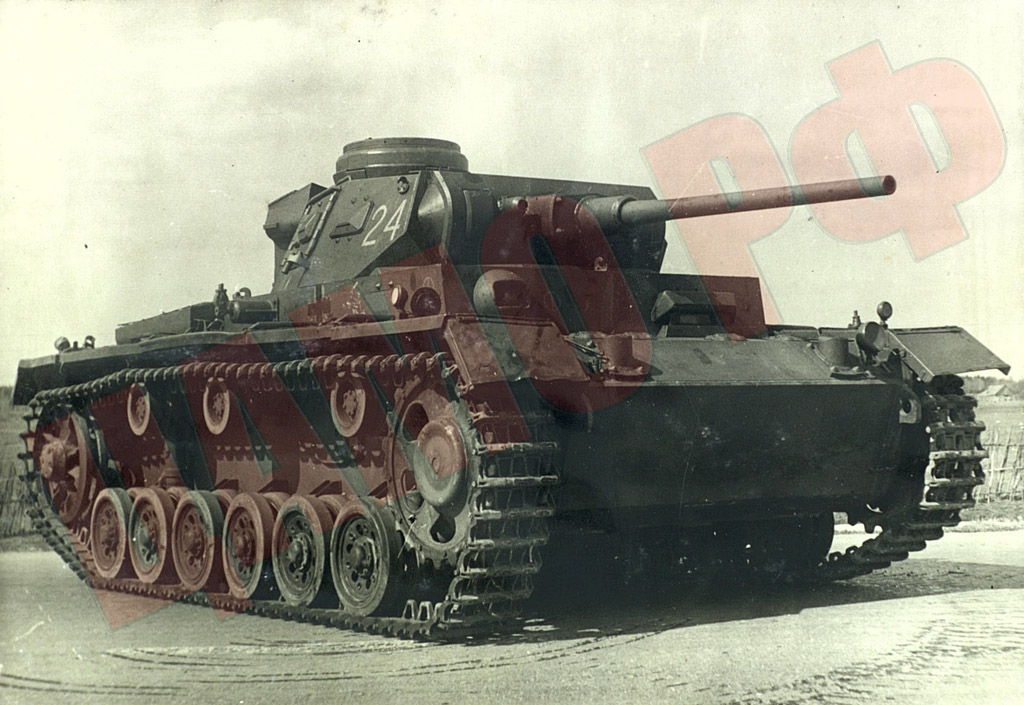Source: http://yuripasholok.livejournal.com/2858031.html
Hello everyone,
Yuri Pasholok posted a nice summary of the Panzer III Ausf.J, standing in Kubinka. Let’s have a look at it.
It’s one of the most mass-produced models of Panzer III, the Ausf.J with 50mm L/60 gun. In Spring 1942, this version was renamed to Ausf.L. These vehicles formed the backbone of the German armored units in 1942 and it was this tank, that fought against Soviet KV’s and T-34′s. This took a heavy toll on them and to this day, only one Ausf.J with L/60 50mm survived, this one – and only because it was captured by the Soviets at some point in 1942.
According to its serial number, it was built in December 1941 by the MAN factory in Nurnberg as one of the first Panzer III’s, equipped with the L/60 KwK 39 – at that point, both models were manufactured in parallel and so this vehicle is a bit older than the last of the L/42 Panzer III’s. According to its documents, this vehicle went to the 15th Panzer Regiment of the 11th Panzer Division. It is not known where or how it was captured, but it definitely happened in 1942.
On the left side of driver’s vision slit, a hole from shell impact can be seen:
According to Yuri Pasholok, museum guides sometimes say that this impact was the reason the tank was abandoned, but it is not so, as when you look at it from the inside, you will see that this shell did not penetrate the armor (the armor held, but not by much). And this is how the vehicle looked in service:






90 minutes exclusive review of Kubinka Tank Museum in HD.
[youtube]http://www.youtube.com/watch?v=M2Amtbi6ftQ[/youtube]
I have a RC replica of this awesome looking tank. I bought it in 2011, a few months before I started playing WOT.
Still one of the best looking tank designs for me.
Indeed, Panzer III with Schurzen, good stuff !
Just look at it!
http://www.vojsko.net/photo/pozemni/tanky/panzer_3_m_01.jpg
Box fetish confirmed.
Personally I’ve always found the early-war German designs (all the way up to the mid-war Tiger, the “Last of the Matchboxes”) to be rather uninspired.
Agreed. The Germans engineers came around with the Panther and Tiger II template, which has a menacing monolithic and yet lean and aggressive look which combines well with the expansionist supremacist ideology.
Personally, I have a soft spot for the British designs. The Matilda and Valentine and Churchill have a bit of an anachronistic touch when put to the backdrop of the tanks of that time, and that’s cute. The Cromwell and its cousins and brothers (TOG, Excellsior) nailed the box-design and then you have the glorious, glorious Centurion. It is tall, it is proud, its name is great and I masturbate to it.
…I could have done without that last bit of knowledge. :x
One writer described the profile of the Cromwell as “almost a child’s sketch of the prototypical tank” what with the boxy body, square turret with the requisite barrel sticking out and the row of big roadwheels along the side… I kinda like the Churchill; the design is somewhat archaic but it fit its intented role quite just fine, and I’m a sucker for tools well suited for their purpose.
Not that fond of the German “cats” personally though – they have the right general idea, but pointlessly bulky execution and a general air of losing sight of the goal. (Srsly, 45+ ton tank with a 75mm gun…?)
The Cromwell is an IKEA tank ; it doesn’t even hide the assembly bolts.
I’m not particularly a fan of late German designs, but they have the look and presence you expect from “miracle” weapons crafted out of desperation by a fascist regime muddled in ideological interferences.
It wasn’t just “any” 75 mm gun. It had better penetration properties than the 88 on the Tiger 1, so I think it fit just fin, sure the german cats were a bit heavy and had large profiles. But thats pretty much what they were intended for? Large ammo supplies for prolonged engagements without constans supply… I don’t know, they would still be limited by fuel though lol
That 75mm gun was supposed to be the main gun for the majority of Tiger’s early on.
The point is, the opponents wouldn’t even consider tanks that heavy if they didn’t have guns *at least* in the ~90mm range (eg. Pershing, IS-1) and the Soviets deliberated between 100 and 122mm pieces for a *heavy* tank only a few tons heavier.
Whereas the 7,5cm L/70 could be fitted into platforms little more than half the Panther’s tonnage. That’s plain poor design, and the Germans only kept reinforcing failure by following the same dubious gun-for-tonnage ratio with arming the half again as heavy Tiger II with a 88mm gun… Conversely roughly contemporaneous American experimental designs in the same weight class *started* with a 105mm weapon and were later tried out with 120 and 155mm pieces while the Soviets pretty much hardcapped even heavy-tank max weight at around 50 tons.
Also the last I checked the size of the German “cats” owed far more to a pigheaded retention of the rear-engine-front-drive powertrain layout (junked by most others already before the war) than any particularly generous amounts of useful internal payload space.
I guess that’s why they performed so poorly against these superior soviet and US designs, amirite?
Becuase raw weight of gun and armour is totes the sole measure of a tank’s effectiveness as a weapon system amirite? Do note that the mid-late war “big cats” violated the Germans’ *own* armoured doctrine by having really shitty strategic maneuverability…
Also, they kinda lost.
IDK… This “Yuri Bitcholok” guy doesn’t make sense… ;P He’s usually researching about German military garbage instead of glorious Soviet equipment.
What a shame. A post about BL series guns from him would attract more attention.
Nah, he’s mostly a Soviet tank person.
Well I didn’t learn much about Soviet tanks from him. Books are much better.
Well i certainly agree with Yuri Sovietolok in that,
no crew would abandon their tank just because of that kind of damage, the only way a crew would abandon their tank is usually because they are no longer able to move at all (blown tracks, drivetrain damage, engine failure would be the most usual).
Theres a record on the fights in 1944 (ardennes offensive) where a king tiger took over 52 hits from various gun calibers, didnt cause spalling, however the side armor (left if im correct) had 3 small penetrations into the cabin, however it wasnt detrimental for the crew and , albeit they where forced to fall back, the tank served the remainer of the campaign with that damage because there was no way to fix it in a proper factory (they used a metal “tampon” to use as a temporary fix, until it was captured by the lack of gas.
Eh, from what I’ve read it was pretty universal SOP to bail out after just about any penetration – both due to the real hazard of ammo cook-off and out of general alarm. Eg. at early stages of Stonne a Pz IV was summarily abandoned by the remaining crew after a 25mm AT gun decapitated the driver through the vision port; as usual whenever the stricken tank failed to catch fire or blow up, it was later reoccupied and brought back into the fray.
Maybe that’s because the dead driver in real life no longer drives the tank around at half speed…
So push the corpse aside and put the assistant driver/bow machine-gunner (the infamous “radioman” in WoT terms) in the seat. :|
As you might imagine, a certain amount of practical psychology is involved.
scumbag russians, put copyright watermark into images they have no copyright to.
So sue them already. /care
so you claim not to care, yet care enough to respond? laff.
nvm, I can see from yoru other post you’re special. no point in discussing the weather with you..
Congratulations on completely missing the meaning.
I’ve seen some of the pictures he posted in books… ;P